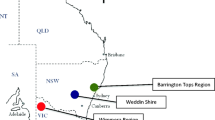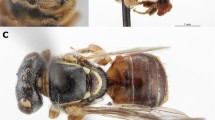Summary
The habitat and nesting biology were studied for naturally occurring colonies of the African honey bee,Apis mellifera scutellata, in the Okavango River Delta, Botswana. Vegetational surveys revealed that the forage available to Delta colonies was abundant and potentially available year round. Colonies had a density of 7.8 nests/km2. Nest cavities occurred with equal frequency in trees and termite mounds, had a volume of approximately 17 L, were unpropolized, and had south-facing, top-located entrances. Delta colonies were small (ca. 6,500 workers), constructed small amounts of comb (ca. 3,000 cm2), stored little food, devoted 78% of comb space to brood production, exhibited little nest defense, and experienced a 48% predation rate during the 5 month study period. The characteristics observed forscutellata in this study are discussed as adaptations to the hot climate, long foraging season, and high predation rate experienced in the Delta. Data for the Delta colonies are compared to those forscutellata in other tropical areas, and to honey bees in temperate climate regions.
Zusammenfassung
Der Lebensraum und die Nestbiologie der Afrikanischen Honigbiene,Apis mellifera scutellata, wurden an Völkern im natürlichen Verbreitungsgebiet im Delta des Okavango Flusses, Botswana, untersucht. Beobachtungen der Vegetation zeigten, daß den Völkern im Delta das ganze Jahr über reichlich Nahrung zur Verfügung steht. Die Koloniedichte betrug 7.8 Nester/km2. Nesthöhlen fanden sich gleich häufig in Bäumen wie in Termitenhügeln, sie hatten ein Volumen von ca. 17 L, waren nicht propolisiert und hatten nach Süden gerichtete, oben liegende Eingänge. Die Völker im Delta waren klein (ca. 6,500 Arbeiterinnen), sie bauten wenig Waben (ca. 3,000 cm2), speicherten wenig Nahrung, verwendeten 78% der Waben für die Brut und sie verfteidigten ihr Nest nur schwach; die Verlustrate durch Räuber betrug 48%. Die charakteristischen Eigenschaften, die fürscutellata in dieser Untersuchung beobachtet wurden, werden als Anpassungen an das heisse Klima, an die lange Trachtperiode und an die im Delta auftretende hohe Verlustrate diskutiert. Die Ergebnisse, die an Völkern im Delta gewonnen wurden, werden verglichen mit Ergebnissen anscutellata in anderen tropischen Gebieten und mit Ergebnissen anscutellata in anderen tropischen Gebieten und mit Ergebnissen an Honigbienen in gemäßigten Klimazonen.
Similar content being viewed by others
References
Boreham M., Roubik D., 1987. — Population change and control of Africanized Honey Bees (Hymenoptera: Apidae) in the Panama Canal area.Bull. Entomol. Soc. Am., 33, 34–39.
Botswanan Dept. Meteorological Services, 1987. —Climatological Summaries for Botswana. Gaborone, Botswana, 10 p.
Claus B., 1983. —Bees and Beekeeping in Botswana. Ministry Agri, Botswana, 122 p.
Cobey S., Locke S., 1986. — The Africanized bee: A tour of Central America.Am. Bee J., 126, 434–440.
Collins A., Rinderer T., Harbo J., Bolten A., 1982. — Colony defense by Africanized and European honeybees.Science, 218, 72–74.
Darchen R., 1973. — La thermorégulation et l'écologie de quelques espèces d'abeilles sociales d'Afrique (Apidae, Trigonini etApis mellifica var.adansonii).Apidologie, 4, 341–370.
Fletcher D., 1978. — The African bee,Apis mellifera adansonii, in Africa.Ann. Rev. Entomol., 23, 151–171.
Galton D., 1971. — Survey of a thousand years of beekeeping in Russia.Bee Research Association, London.
Gary N., Lorenzen K., 1980. — How to construct and maintain an observation bee hive.Div. Agri. Sci., Univ. California. Leaflet 2853.
Johannsmeier M., 1979. — Termite mounds as nesting sites for colonies of the African honeybee.S. Afr. Bee J., 51, 9–14.
Michener C., 1975. — The Brazilian bee problem.Ann. Rev. Entomol., 20, 399–416.
Nightingale J., 1976. — Traditional beekeeping among Kenya tribes and methods proposed for improvement and modernization. In:E. Crane (ed.),Apiculture in Tropical Climates. International Bee Research Association, London, p. 15–22.
Otis G., 1982. — Population biology of the Africanized honey bee. In: P. Jaisson (ed.),Social Insects in the Tropics. Proc. Symp. I.U.S.S.I. Cocoyoc, Mexico, p. 209–219.
Palgrave K., 1984. —Trees of Southern Africa. C. Struik Publ., Cape Town, South Africa, 959 p.
Ruttner F., 1977. — The present knowledge on the taxonomy of African races of bees. In: D. Fletcher (ed.),African Bees: Taxonomy, Biology, and Economic Use. Apimondia, Pretoria., p. 50–54.
Ruttner F., 1975. — Races of bees. In: Dadant and Sons (Eds.),The Hive and the Honeybee. Dadant and Sons, Hamilton, Illinois, p. 19–38.
Ruttner F., 1976. — Honeybees in the tropics: their variety and characteristics of importance for apiculture. In: E. Crane (ed.),Apiculture in Tropical Climates. International Bee Research Association, London, p. 41–46.
Schneider S., Stamps J., Gary N., 1986. — The vibration dance of the honey bee. I. Communication regulating foraging on two time scales.Anim. Behav., 34, 377–385.
Seeley T., 1985. —Honeybee Ecology: A Study of Adaptation in Social Life. Princeton Univ. Press, Princeton, New Jersey, 201 p.
Seeley T., 1982. — Adaptive significance of the age polyethism schedule in honeybee colonies.Behav. Ecol. Sociobiol., 11, 287–293.
Seeley T., Visscher K., 1985. — Survival of honeybees in cold climates: the critical timing of colony growth and reproduction.Ecol. Entomol., 10, 81–88.
Seeley T., Morse R., 1978. — Nest site selection by the honey bee.Insect. Soc., 25, 323–337.
Seeley T., Morse R., 1976. — The nest of the honeybee (Apis mellifera L.).Insect. Soc., 23, 495–512.
Silberrad R., 1976. —Bee-keeping in Zambia. Apimondia, Bucharest, 74 p.
Visscher K., Seeley T., 1982. — Foraging strategy of honeybee colonies in a temperate deciduous forest.Ecoloy, 63, 1790–1801.
Winston M., 1980. — Seasonal patterns of brood rearing and worker longevity in colonies of the Africanized honey bee (Hymenoptera: Apidae) in South America.J. Kansas Entomol. Soc., 53, 157–165.
Winston M., 1979. — Intra-colony demography and reproductive rate of the Africanized honeybee in South America.Behav. Ecol. Sociobiol., 4, 279–292.
Winston M., Taylor O., Otis G., 1983. — Some differences between temperate European and tropical South American honeybees.Bee World, 64, 12–21.
Winston M., Dropkin J., Taylor O., 1981. — Demography and life history characteristics of two honey bee races (Apis mellifera).Oecologia, 48, 407–413.
Winston M., Taylor O., 1980. — Factors preceding queen rearing in the Africanized honeybee (Apis mellifera) in South America.Insect. Soc., 27, 289–304.
Winston M., Otis G., Taylor O., 1979. — Absconding behaviour of the Africanized honeybee in South America.J. Apic. Res., 18, 85–94.
Author information
Authors and Affiliations
Rights and permissions
About this article
Cite this article
Schneider, S., Blyther, R. The habitat and nesting biology of the African honey beeApis mellifera scutellata in the Okavango River Delta, Botswana, Africa. Ins. Soc 35, 167–181 (1988). https://doi.org/10.1007/BF02223930
Received:
Accepted:
Issue Date:
DOI: https://doi.org/10.1007/BF02223930




